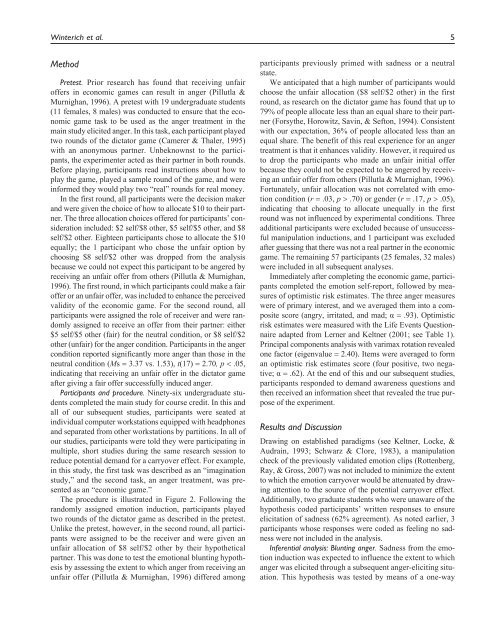The Role of Cognitive Appraisals in Emotional Blunting - Projects at ...
The Role of Cognitive Appraisals in Emotional Blunting - Projects at ...
The Role of Cognitive Appraisals in Emotional Blunting - Projects at ...
Create successful ePaper yourself
Turn your PDF publications into a flip-book with our unique Google optimized e-Paper software.
W<strong>in</strong>terich et al. 5MethodPretest. Prior research has found th<strong>at</strong> receiv<strong>in</strong>g unfair<strong>of</strong>fers <strong>in</strong> economic games can result <strong>in</strong> anger (Pillutla &Murnighan, 1996). A pretest with 19 undergradu<strong>at</strong>e students(11 females, 8 males) was conducted to ensure th<strong>at</strong> the economicgame task to be used as the anger tre<strong>at</strong>ment <strong>in</strong> thema<strong>in</strong> study elicited anger. In this task, each participant playedtwo rounds <strong>of</strong> the dict<strong>at</strong>or game (Camerer & Thaler, 1995)with an anonymous partner. Unbeknownst to the participants,the experimenter acted as their partner <strong>in</strong> both rounds.Before play<strong>in</strong>g, participants read <strong>in</strong>structions about how toplay the game, played a sample round <strong>of</strong> the game, and were<strong>in</strong>formed they would play two “real” rounds for real money.In the first round, all participants were the decision makerand were given the choice <strong>of</strong> how to alloc<strong>at</strong>e $10 to their partner.<strong>The</strong> three alloc<strong>at</strong>ion choices <strong>of</strong>fered for participants’ consider<strong>at</strong>ion<strong>in</strong>cluded: $2 self/$8 other, $5 self/$5 other, and $8self/$2 other. Eighteen participants chose to alloc<strong>at</strong>e the $10equally; the 1 participant who chose the unfair option bychoos<strong>in</strong>g $8 self/$2 other was dropped from the analysisbecause we could not expect this participant to be angered byreceiv<strong>in</strong>g an unfair <strong>of</strong>fer from others (Pillutla & Murnighan,1996). <strong>The</strong> first round, <strong>in</strong> which participants could make a fair<strong>of</strong>fer or an unfair <strong>of</strong>fer, was <strong>in</strong>cluded to enhance the perceivedvalidity <strong>of</strong> the economic game. For the second round, allparticipants were assigned the role <strong>of</strong> receiver and were randomlyassigned to receive an <strong>of</strong>fer from their partner: either$5 self/$5 other (fair) for the neutral condition, or $8 self/$2other (unfair) for the anger condition. Participants <strong>in</strong> the angercondition reported significantly more anger than those <strong>in</strong> theneutral condition (Ms 3.37 vs. 1.53), t(17) 2.70, p .05,<strong>in</strong>dic<strong>at</strong><strong>in</strong>g th<strong>at</strong> receiv<strong>in</strong>g an unfair <strong>of</strong>fer <strong>in</strong> the dict<strong>at</strong>or gameafter giv<strong>in</strong>g a fair <strong>of</strong>fer successfully <strong>in</strong>duced anger.Participants and procedure. N<strong>in</strong>ety-six undergradu<strong>at</strong>e studentscompleted the ma<strong>in</strong> study for course credit. In this andall <strong>of</strong> our subsequent studies, participants were se<strong>at</strong>ed <strong>at</strong><strong>in</strong>dividual computer workst<strong>at</strong>ions equipped with headphonesand separ<strong>at</strong>ed from other workst<strong>at</strong>ions by partitions. In all <strong>of</strong>our studies, participants were told they were particip<strong>at</strong><strong>in</strong>g <strong>in</strong>multiple, short studies dur<strong>in</strong>g the same research session toreduce potential demand for a carryover effect. For example,<strong>in</strong> this study, the first task was described as an “imag<strong>in</strong><strong>at</strong>ionstudy,” and the second task, an anger tre<strong>at</strong>ment, was presentedas an “economic game.”<strong>The</strong> procedure is illustr<strong>at</strong>ed <strong>in</strong> Figure 2. Follow<strong>in</strong>g therandomly assigned emotion <strong>in</strong>duction, participants playedtwo rounds <strong>of</strong> the dict<strong>at</strong>or game as described <strong>in</strong> the pretest.Unlike the pretest, however, <strong>in</strong> the second round, all participantswere assigned to be the receiver and were given anunfair alloc<strong>at</strong>ion <strong>of</strong> $8 self/$2 other by their hypotheticalpartner. This was done to test the emotional blunt<strong>in</strong>g hypothesisby assess<strong>in</strong>g the extent to which anger from receiv<strong>in</strong>g anunfair <strong>of</strong>fer (Pillutla & Murnighan, 1996) differed amongparticipants previously primed with sadness or a neutralst<strong>at</strong>e.We anticip<strong>at</strong>ed th<strong>at</strong> a high number <strong>of</strong> participants wouldchoose the unfair alloc<strong>at</strong>ion ($8 self/$2 other) <strong>in</strong> the firstround, as research on the dict<strong>at</strong>or game has found th<strong>at</strong> up to79% <strong>of</strong> people alloc<strong>at</strong>e less than an equal share to their partner(Forsythe, Horowitz, Sav<strong>in</strong>, & Sefton, 1994). Consistentwith our expect<strong>at</strong>ion, 36% <strong>of</strong> people alloc<strong>at</strong>ed less than anequal share. <strong>The</strong> benefit <strong>of</strong> this real experience for an angertre<strong>at</strong>ment is th<strong>at</strong> it enhances validity. However, it required usto drop the participants who made an unfair <strong>in</strong>itial <strong>of</strong>ferbecause they could not be expected to be angered by receiv<strong>in</strong>gan unfair <strong>of</strong>fer from others (Pillutla & Murnighan, 1996).Fortun<strong>at</strong>ely, unfair alloc<strong>at</strong>ion was not correl<strong>at</strong>ed with emotioncondition (r .03, p .70) or gender (r .17, p .05),<strong>in</strong>dic<strong>at</strong><strong>in</strong>g th<strong>at</strong> choos<strong>in</strong>g to alloc<strong>at</strong>e unequally <strong>in</strong> the firstround was not <strong>in</strong>fluenced by experimental conditions. Threeadditional participants were excluded because <strong>of</strong> unsuccessfulmanipul<strong>at</strong>ion <strong>in</strong>ductions, and 1 participant was excludedafter guess<strong>in</strong>g th<strong>at</strong> there was not a real partner <strong>in</strong> the economicgame. <strong>The</strong> rema<strong>in</strong><strong>in</strong>g 57 participants (25 females, 32 males)were <strong>in</strong>cluded <strong>in</strong> all subsequent analyses.Immedi<strong>at</strong>ely after complet<strong>in</strong>g the economic game, participantscompleted the emotion self-report, followed by measures<strong>of</strong> optimistic risk estim<strong>at</strong>es. <strong>The</strong> three anger measureswere <strong>of</strong> primary <strong>in</strong>terest, and we averaged them <strong>in</strong>to a compositescore (angry, irrit<strong>at</strong>ed, and mad; α .93). Optimisticrisk estim<strong>at</strong>es were measured with the Life Events Questionnaireadapted from Lerner and Keltner (2001; see Table 1).Pr<strong>in</strong>cipal components analysis with varimax rot<strong>at</strong>ion revealedone factor (eigenvalue 2.40). Items were averaged to forman optimistic risk estim<strong>at</strong>es score (four positive, two neg<strong>at</strong>ive;α .62). At the end <strong>of</strong> this and our subsequent studies,participants responded to demand awareness questions andthen received an <strong>in</strong>form<strong>at</strong>ion sheet th<strong>at</strong> revealed the true purpose<strong>of</strong> the experiment.Results and DiscussionDraw<strong>in</strong>g on established paradigms (see Keltner, Locke, &Audra<strong>in</strong>, 1993; Schwarz & Clore, 1983), a manipul<strong>at</strong>ioncheck <strong>of</strong> the previously valid<strong>at</strong>ed emotion clips (Rottenberg,Ray, & Gross, 2007) was not <strong>in</strong>cluded to m<strong>in</strong>imize the extentto which the emotion carryover would be <strong>at</strong>tenu<strong>at</strong>ed by draw<strong>in</strong>g<strong>at</strong>tention to the source <strong>of</strong> the potential carryover effect.Additionally, two gradu<strong>at</strong>e students who were unaware <strong>of</strong> thehypothesis coded participants’ written responses to ensureelicit<strong>at</strong>ion <strong>of</strong> sadness (62% agreement). As noted earlier, 3participants whose responses were coded as feel<strong>in</strong>g no sadnesswere not <strong>in</strong>cluded <strong>in</strong> the analysis.Inferential analysis: Blunt<strong>in</strong>g anger. Sadness from the emotion<strong>in</strong>duction was expected to <strong>in</strong>fluence the extent to whichanger was elicited through a subsequent anger-elicit<strong>in</strong>g situ<strong>at</strong>ion.This hypothesis was tested by means <strong>of</strong> a one-way
















